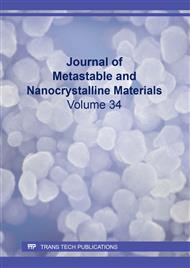p.1
p.19
p.37
p.45
p.63
Correlation between Microstructure and Impact Toughness of Austempered High Carbon Steels in Bru State, Silicon, Nickel and Manganese Variant
Abstract:
The insertion of bainite as a total or partial substitute for martensite is a promising option concerning the combination of high strength and toughness, properties mainly sought after by the aerospace and high technology industries. High-carbon, carbide-free bainitic steels are obtained through thermomechanical processing, with a final microstructure consisting of bainitic ferrite and retained austenite. The presence of carbides in these steels can reduce fracture toughness when compared to conventional quenched and tempered steels. This article aims to correlate the microstructure and impact resistance of four high carbon steel alloys with varying contents of Nickel, Silicon, and Manganese, which were austenitized at 870 °C and austempered at 280 °C at 12-hour intervals, 24 hours, 72 hours, and 168 hours. Thus, the microstructural characteristics, their morphological and kinetic aspects were determined, evaluating the mechanical properties from Rockwell C hardness tests, where commonly in the four alloys there is a decrease in the hardness values, due to the stress relief that occurred during the treatment of austempered, causing the bainitic microstructure to have larger lath shapes, causing a drop in hardness values in the impact test. For the fractographic analysis of the samples using scanning electron microscopy (SEM), the analyses showed three stages of the phase transformation: martensitic microstructure; multiphase microstructure composed of bainitic ferrite, martensite, and retained austenite; microstructure formed by bainitic ferrite and retained austenite, due to the stasis of the bainitic reaction. The alloys obtained lower rates of energy absorption in the initial times (from 24 hours) due to the instability of the austenite which consequently generated an increase in the energy absorption capacity, obtained from the energy dissipated by the impact of the Charpy test the effect called plasticity. Transformation-induced (TRIP) phenomenon causing when austenite becomes martensite, thus favoring increased ductility. Finally, it was observed that alloy (a), with lower content (%) of nickel, has a predominance of brittle fracture, as a microcleavage mechanism resulting from a combined action of a failure micromechanism. For alloy (c) with higher nickel content (%), the predominant fracture is also of the brittle type, with the presence of small microcavities common to the alveoli. The other important point to be considered is the influence of the treatment time, which does not interfere in the failure mechanism, remaining fragile until the end for alloy (a), alloy (b), and alloy (c).
Info:
Periodical:
Pages:
19-36
Citation:
Online since:
July 2022
Authors:
Keywords:
Price:
Сopyright:
© 2022 Trans Tech Publications Ltd. All Rights Reserved
Share:
Citation:


